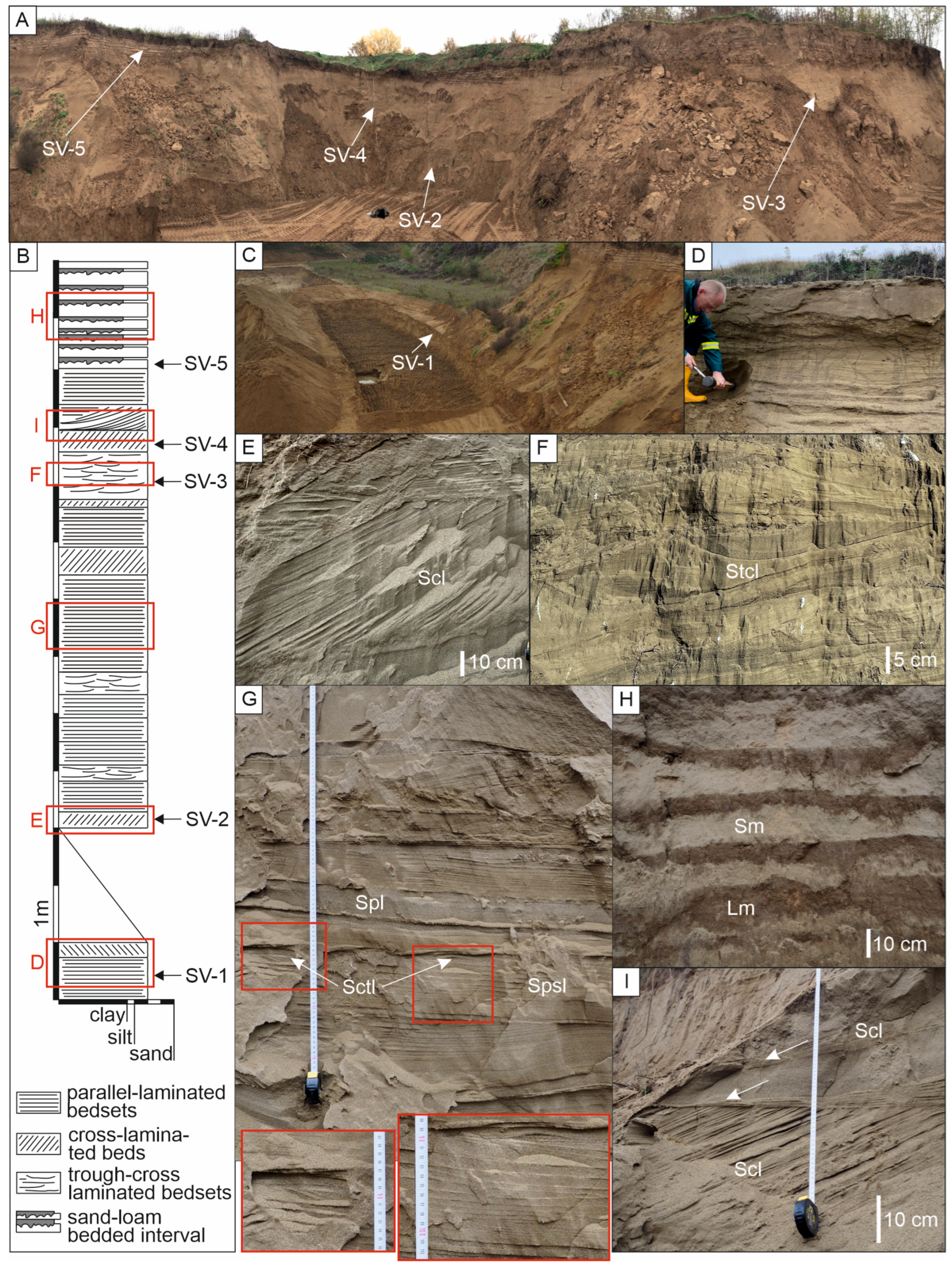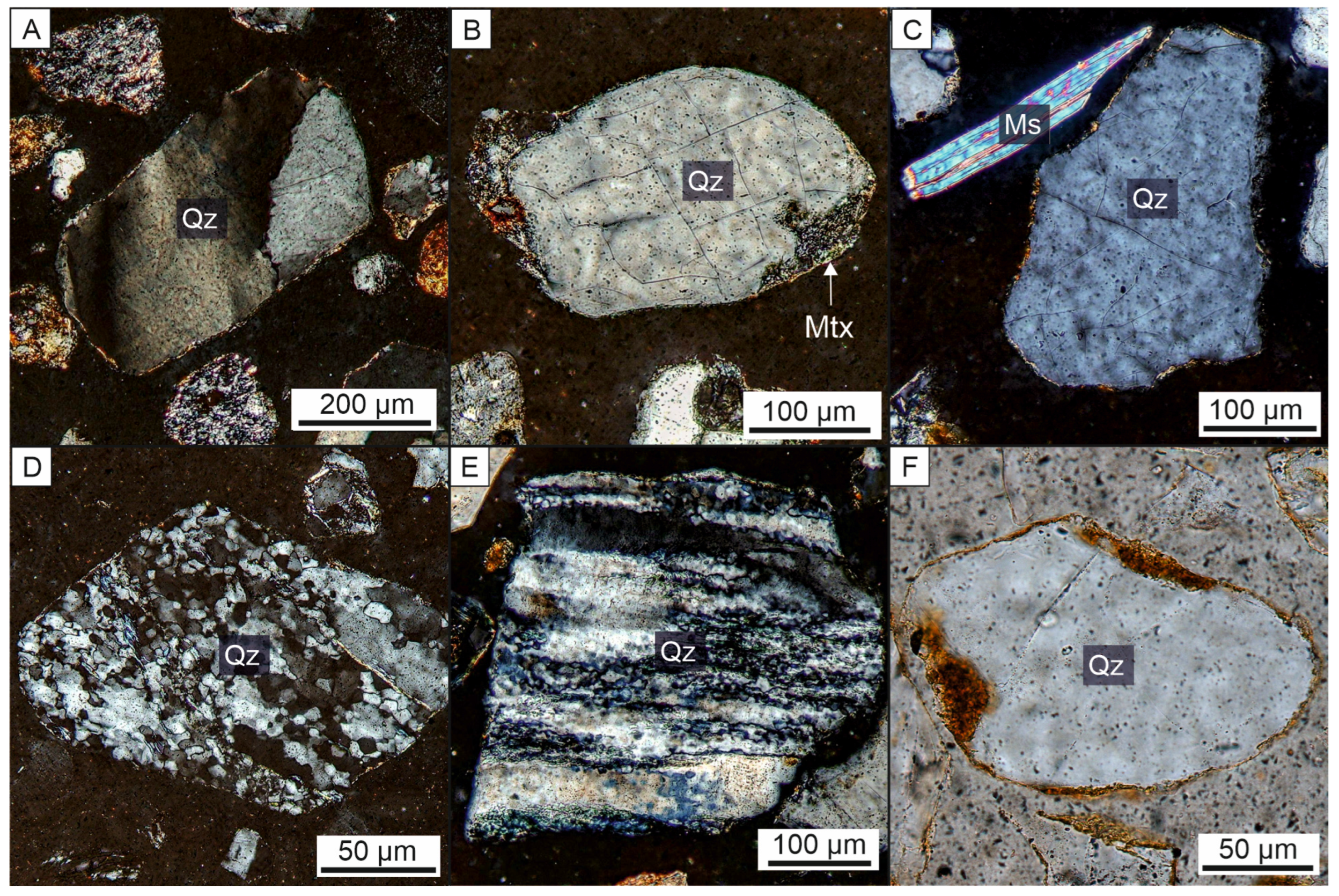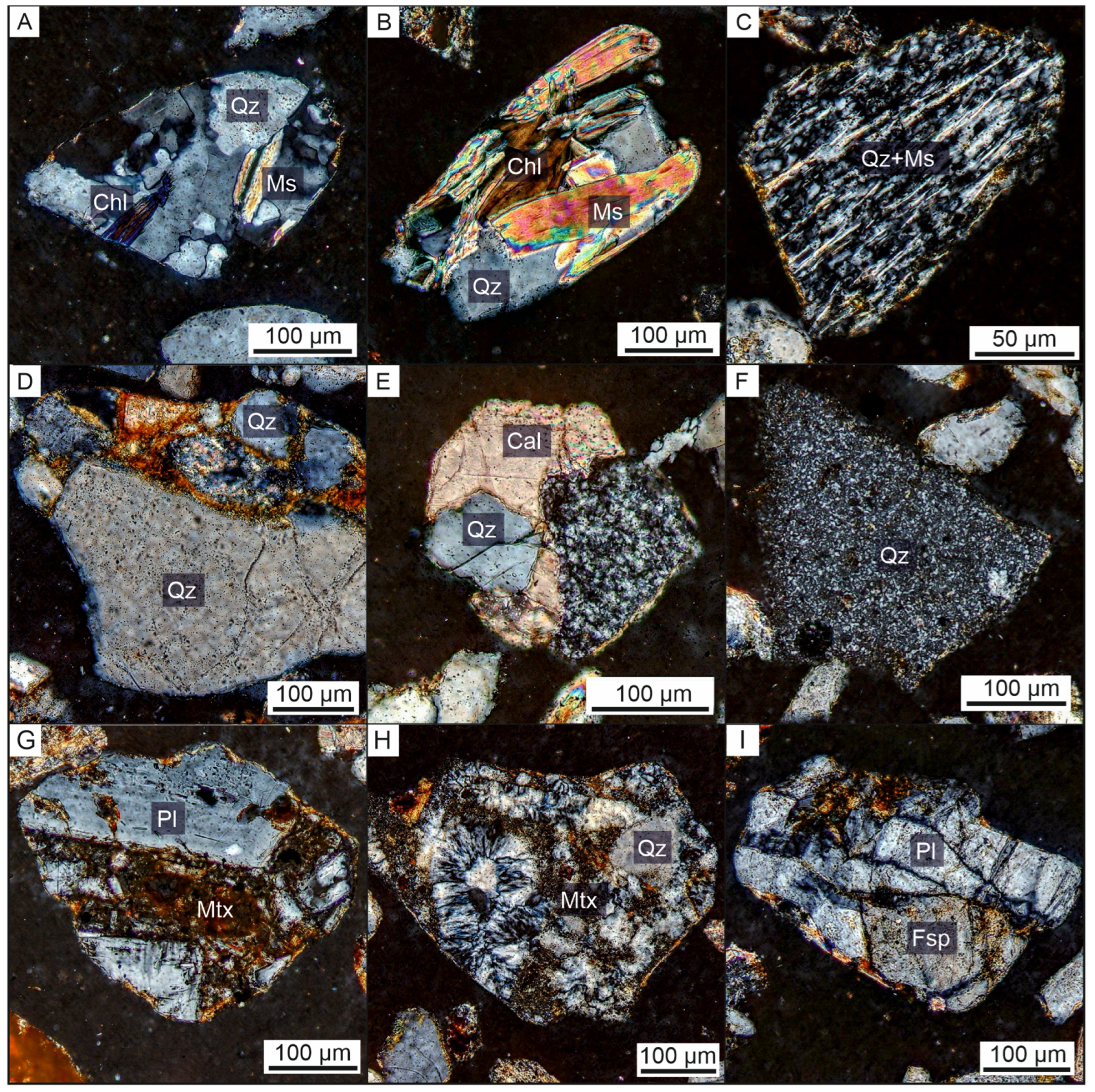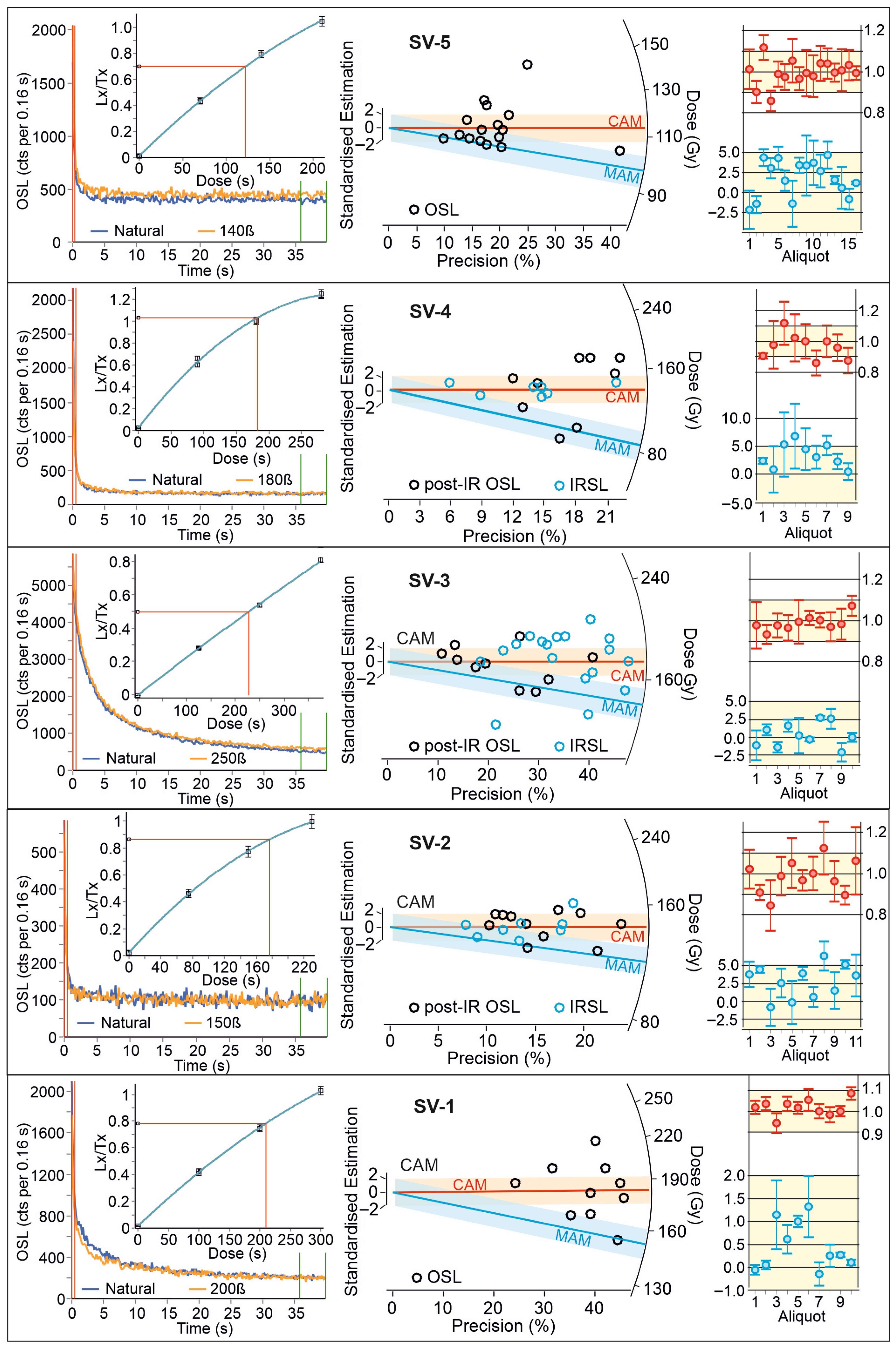Age of Blown Sand in the East Slovak Lowland—Case Study from Svätuše Sand Pit, Slovakia
Abstract
1. Introduction
2. Location and Geological Settings of the Study Area


3. Materials and Methods
3.1. Sedimentary and Petrographic Analysis
3.2. Sampling and Sample Preparation for Dating
3.3. Optically Stimulated Luminescence (OSL) Dating
3.4. Dose Rate Analysis
4. Results and Interpretation
4.1. Grain Size Analysis
4.2. Sedimentological Analysis
4.2.1. Parallel Laminated Bedsets
4.2.2. Cross-Laminated Beds
4.2.3. Trough-Cross Laminated Bedsets
4.2.4. Sand-Loam Bedded Interval
4.3. Petrographic Analysis
4.4. Age Determination by the OSL Method
5. Discussion
6. Conclusions
Author Contributions
Funding
Data Availability Statement
Acknowledgments
Conflicts of Interest
References
- Koster, E.A. Recent advances in luminescence dating of Late Pleistocene (cold climate) aeolian sand and loess deposits in western Europe. Permafr. Periglac. Process. 2005, 16, 131–143. [Google Scholar] [CrossRef]
- Lóki, J.; Négyesi, G.; Buró, B.; Félegyházi, E. Aeolian Surface transformations on the Alluvial fan of the Nyírség. J. Environ. Geogr. 2012, 5, 21–28. [Google Scholar] [CrossRef]
- Kadlec, J.; Kocurek, G.; Mohrig, D.; Shinde, D.P.; Murari, M.K.; Varma, V.; Stehlík, F.; Beneš, V.; Singhvi, A.K. Response of fluvial, aeolian, and lacustrine systems to late Pleistocene to Holocene climate change, Lower Moravian Basin, Czech Republic. Geomorphology 2015, 232, 193–208. [Google Scholar] [CrossRef]
- Moravcová, M.; Fordinál, K.; Maglay, J. Late Quaternary History and Palaeoclimatic Implications of Danubian Flat Based on Dating, Geochemistry, Lithology, Isotope Analyses and Land Snail Assemblages. Slovak Geol. Mag. 2018, 18, 31–70. [Google Scholar]
- Rychel, J.; Woronko, B.; Błaszkiewicz, M.; Karasziewicz, T. Aeolian processes records within last glacial limit areas based on the Płock Basin case (Central Poland). Bull. Geol. Soc. Finl. 2018, 90, 223–237. [Google Scholar] [CrossRef]
- Holuša, J.; Moska, P.; Nývlt, D.; Woronko, B. OSL-based chronology of the cold-climate aeolian sand dunes, Moravian Sahara, lower Morava Basin, Czechia. Quat. Sci. Rev. 2024, 334, 1–13. [Google Scholar] [CrossRef]
- Kvitkovič, J. Concerning the basic geomorphological problems of the East Slovakian Lowland. Geogr. Mag. 1964, XVI, 143–159. [Google Scholar]
- Baňacký, V.; Elečko, M.; Kaličiak, M.; Straka, P.; Škvarka, Ľ.; Šucha, P.; Vass, D.; Vozárová, A.; Vozár, J. Explanations to the Geological Map of the Southern Part of East Slovak Lowland and Zemplínske Vrchy Mts; State Geological Institute of Dionýz Štúr: Bratislava, Slovakia, 1989; pp. 1–143. [Google Scholar]
- Košťálik, J. Contribution to the study of the genesis and stratigraphy of eolian sand of the southern part of the East Slovak Lowland. Geogr. Cassoviensis 2009, III, 81–91. [Google Scholar]
- Košťálik, J. Eolic sediments in Western Carpathians, their characterisation and chronostratigraphy. Acta Mont. Slovaca 1997, 2, 39–41. [Google Scholar]
- Ložek, V. Research of Deposits of Natural Fertilizers in Eastern Slovakia; State Geological Institute of Dionýz Štúr: Bratislava, Slovakia, 1963; pp. 346–348. [Google Scholar]
- Schmidt, Z. Quaternary Molluscs of the Southern Part of the East Slovak Lowland; State Geological Institute of Dionýz Štúr: Bratislava, Slovakia, 1974. [Google Scholar]
- Pelíšek, J. Characteristics of the blown sands of Slovakia. Geol. Work 1963, 64, 103–120. [Google Scholar]
- Horniš, J. Sedimentary-Petrographic Analysis of Quaternary Sediments of the East Slovak Lowland; State Geological Institute of Dionýz Štúr: Bratislava, Slovakia, 1977; pp. 1–72. [Google Scholar]
- Bónová, K.; Bóna, J.; Mikuš, T.; Ferková, A. Heavy minerals of the aeolian sediments in the East Slovak Basin (Western Carpathians)—Implications for their origin, transport process and sedimentary history. Aeolian Res. 2024, 66, 1–18. [Google Scholar] [CrossRef]
- Kvitkovič, J.; Lukniš, M.; Mazúr, E. Geomorphology and Quaternary of Slovak lowlands. Geogr. Mag. 1956, 8, 101–106. [Google Scholar]
- Csongor, E.; Borsy, Z.; Szabó, I. Age of charcoal samples of geomorphologic interest in Northeast Hungary. Radiocarbon 1980, 22, 774–777. [Google Scholar] [CrossRef]
- Ujházy, K.; Gábris, G.; Frechen, M. Ages of periods of sand movement in Hungary determined through luminescence measurements. Quat. Int. 2003, 111, 91–100. [Google Scholar] [CrossRef]
- Lóki, J.; Demeter, G.; Négyesi, G.; Vass, R.; Molnár, M. Holocene sand movements in the Nyírség area. In Studies in the Field of Geology in Honor of Dr. Miklós Kozák; Püspöki, Z., Ed.; University of Debrecen: Debrecen, Hungary, 2008; pp. 111–123. [Google Scholar]
- Gábris, G.Y. The stages of the last 30 years of geological history and the main periods of the movement of blown sand in Hungary. Hung. Geogr. Bull. 2003, CXXVII, 1–14. [Google Scholar]
- Baňacký, V.; Elečko, M.; Kaličiak, M.; Lexa, J.; Straka, P.; Vass, D.; Vozár, J.; Vozárová, A. Geological Map of the Southern Part of East Slovak Lowland and Zemplínske Vrchy Mts. at Scale 1:50000; State Geological Institute of Dionýz Štúr: Bratislava, Slovakia, 1986. [Google Scholar]
- Jacko, S.; Jacko, S.; Labant, S.; Bátorová, K.; Farkašovský, R.; Ščerbáková, B. Structural constraints of neotectonic activity in the eastern part of the Western Carpathians orogenic wedge. Quat. Int. 2021, 585, 27–43. [Google Scholar] [CrossRef]
- Vass, D.; Elečko, M.; Janočko, J.; Karoli, S.; Pereszlenyi, M.; Slávik, J.; Kaličiak, M. Palaeogeography of the East-Slovakian Basin. Slovak Geol. Mag. 2000, 4, 377–407. [Google Scholar]
- Maglay, J.; Halouzka, R.; Baňacký, V.; Pristaš, J.; Janočko, J. Neotectonic Map of Slovakia 1:500,000; Ministry of Environment of Slovak Republic: Bratislava, Slovakia, 1999. [Google Scholar]
- Wentworth, C.K. A scale of grade and class terms for clastic sediments. J. Geol. 1922, 30, 377–392. [Google Scholar] [CrossRef]
- Folk, R.L.; Ward, W.C. Brazos River bar: A study in the significance of grain size parameters. J. Sediment. Petrol. 1957, 27, 3–26. [Google Scholar] [CrossRef]
- Folk, R.L. Petrology of Sedimentary Rocks; Hemphill Publishing Company: Austin, TX, USA, 1980; pp. 1–182. [Google Scholar]
- Pettijohn, F.J.; Potter, P.E.; Siever, R. Sand and Sandstone, 2nd ed.; Springer: Berlin/Heidelberg, Germany, 1987; pp. 139–213. [Google Scholar]
- Murray, A.; Arnold, L.; Buykaert, J.-P.; Guérin, G.; Qin, J.; Singhvi, A.; Smedley, R.; Thomsen, K. Optically stimulated luminescence dating using quartz. Nat. Rev. Method Prim. 2021, 1, 1–31. [Google Scholar] [CrossRef]
- Murray, A.S.; Roberts, R.G.; Wintle, A.G. Equivalent dose measurement using a single aliquot of quartz. Radiat. Meas. 1997, 27, 171–184. [Google Scholar] [CrossRef]
- Murray, A.S.; Roberts, R.G. Measurement of the equivalent dose in quartz using a regenerative-dose single-aliquot protocol. Radiat. Meas. 1998, 29, 503–515. [Google Scholar] [CrossRef]
- Murray, A.S.; Wintle, A.G. Luminescence dating of quartz using an improved single-aliquot regenerative-dose protocol. Radiat. Meas. 2000, 32, 57–73. [Google Scholar] [CrossRef]
- Gilmore, G.R. Practical Gamma-Ray Spectrometry, 2nd ed.; John Wiley & Sons, Ltd.: Hoboken, NJ, USA, 2008; pp. 1–381. [Google Scholar]
- Guérin, G.; Mercier, N.; Nathan, R.; Adamiec, G.; Lefrais, Y. On the use of the infinite matrix assumption and associated concepts: A critical review. Radiat. Meas. 2012, 47, 778–785. [Google Scholar] [CrossRef]
- Bristow, C.; Mountney, N.P. Aeolian Stratigraphy. In Treatise on Geomorphology; Shroder, J.F., Ed.; Elsevier: San Diego, CA, USA, 2013; pp. 246–268. [Google Scholar]
- Hunter, R.E. Basic types of stratification in small eolian dunes. Sedimentology 1977, 24, 361–387. [Google Scholar] [CrossRef]
- Wallinga, J.; Murray, A.S.; Bøtter-Jensen, L. Measurement of the dose in quartz in the presence of feldspar contamination. Radiat. Prot. Dosim. 2002, 101, 367–370. [Google Scholar] [CrossRef]
- Galbraith, R.F.; Laslett, G.M. Statistical models for mixed fission track ages. Nucl. Tracks Radiat. Meas. 1993, 21, 459–470. [Google Scholar] [CrossRef]
- Fattahi, M.; Heidary, M.; Ghasemi, M. Employing minimum age model (MAM) and finite mixture modeling (FMM) for OSL age determination of two important samples from Ira trench of North Tehran fault. Geochronometria 2016, 43, 38–47. [Google Scholar] [CrossRef]
- Ivy-Ochs, S.; Kerschner, H.; Reuther, A.; Preusser, F.; Heine, K.; Maisch, M.; Kubik, P.W.; Schlüchter, C. Chronology of the last glacial cycle in the European Alps. J. Quat. Sci. 2008, 23, 559–573. [Google Scholar] [CrossRef]
- Peeters, J.; Cohen, K.M.; Thrana, C.; Busschers, F.S.; Martinius, A.W.; Stouthamer, E.; Middekoop, H. Preservation of Last Interglacial and Holocene transgressive systems tracts in the Netherlands and its applicability as a North Sea Basin reservoir analogue. Earth-Sci. Rev. 2019, 188, 482–497. [Google Scholar] [CrossRef]
- Cohen, K.; Gibbard, P. Global Chronostratigraphical Correlation Table for the Last 2.7 Million Years v. 2019 (Poster Version), 2nd ed.; Mendeley Data: London, UK, 2022. [Google Scholar]
- Borsy, Z.; Csongor, É.; Lóki, J.; Szabó, I. Recent results in the radiocarbon dating of wind-blown sand movements in Tisza Bodrog Interfluve. Acta Geogr. Debrec. 1985, 22, 5–16. [Google Scholar]
- Borsy, Z. Blown sand territories in Hungary. Z. Für Geomorphol. 1991, 90, 1–14. [Google Scholar]
- Nyári, D.; Kiss, T. Holocene quicksand movements in Bács-Kiskun County in the light of archaeological finds. Cumania 2005, 21, 83–89. [Google Scholar]
- Marks, L.; Gałązka, D.; Woronko, B. Climate, environment and stratigraphy of the last Pleistocene glacial stage in Poland. Quat. Int. 2016, 420, 259–271. [Google Scholar] [CrossRef]
- Goździk, J. The Vistulian aeolian succession in central Poland. Sediment. Geol. 2007, 193, 211–220. [Google Scholar] [CrossRef]
- Krzyszkowski, D. Saalian sediments of the Bełchatów outcrop, central Poland. Boreas 1991, 20, 29–46. [Google Scholar] [CrossRef]
- Mello, M.; Lapin, M.; Pecho, J. Climate in the Past and Present in the Slovak Landscapes—The Central European Context. In Landscapes and Landforms of Slovakia; Lehotský, M., Boltižiar, M., Eds.; Springer Nature: Cham, Switzerland, 2022; pp. 27–45. [Google Scholar]





| Sample | Grain Size (%) | Mean (ϕ) | Median (ϕ) | Sorting (ϕ) | Skewness (ϕ) | Kurtosis (ϕ) | ||||
|---|---|---|---|---|---|---|---|---|---|---|
| Mud/Coarse Silt | Sand | |||||||||
| Very Fine | Fine | Medium | Coarse | |||||||
| SV-5 | 3.6 | 13.5 | 64.9 | 17.6 | 0.5 | 2.5 | 2.5 | moderately well | symmetrical | leptokurtic |
| SV-4 | 1.3 | 15.8 | 70.9 | 11.6 | 0.2 | 2.5 | 2.5 | well | negative phi values | leptokurtic |
| SV-3 | 2.2 | 13.9 | 57.6 | 25.0 | 1.3 | 2.4 | 2.4 | moderately well | symmetrical | leptokurtic |
| SV-2 | 0.7 | 11.0 | 43.5 | 43.0 | 2.0 | 2.1 | 2.1 | moderately well | symmetrical | platykurtic |
| SV-1 | 7.8 | 35.9 | 44.6 | 10.9 | 0.1 | 2.8 | 2.9 | moderately well | negative phi values | mesokurtic |
| Sample | Depth (cm) | Ra-226 (Bq/kg) | Th-232 (Bq/kg) | K-40 (Bq/kg) | Dose Rate (Gy/kyr) | Water (%) | Aliquots * | Equivalent Dose (Gy) Minimum/Average | Age (kyr) |
|---|---|---|---|---|---|---|---|---|---|
| SV-5 | 200 | 15.5 ± 2.5 | 15.4 ± 4.3 | 290 ± 21 | 1.5 ± 0.1 | 13.0 | 20/16 | 97.82 ± 1.2/ 111.7 ± 4.8 | 67.0 ± 3.9 |
| SV-4 | 400 | 14.6 ± 2.4 | 14.7 ± 4.1 | 283 ± 21 | 1.3 ± 0.1 | 18.0 | 20/9 | 90.0 ± 8.5/ 151.5 ± 13.0 | 68.1 ± 7.5 |
| SV-3 | 500 | 14.2 ± 3.0 | 14.9 ± 4.2 | 289 ± 22 | 1.4 ± 0.1 | 14.0 | 20/10 | 144.0 ± 1.3/ 173.2 ± 8.3 | 105.33 ± 6.2 |
| SV-2 | 900 | 13.4 ± 2.2 | 13.2 ± 3.8 | 290 ± 21 | 1.2 ± 0.1 | 20.0 | 20/11 | 116.3 ± 3.9/ 147.6 ± 5.9 | 94.6 ± 6.3 |
| SV-1 | 1200 | 22.1 ± 3.5 | 19.9 ± 4.6 | 298 ± 22 | 1.5 ± 0.1 | 11.0 | 10/10 | 153.81 ± 10.93/ 181.4 ± 6.3 | 100.5 ± 9.3 |
Disclaimer/Publisher’s Note: The statements, opinions and data contained in all publications are solely those of the individual author(s) and contributor(s) and not of MDPI and/or the editor(s). MDPI and/or the editor(s) disclaim responsibility for any injury to people or property resulting from any ideas, methods, instructions or products referred to in the content. |
© 2025 by the authors. Licensee MDPI, Basel, Switzerland. This article is an open access article distributed under the terms and conditions of the Creative Commons Attribution (CC BY) license (https://creativecommons.org/licenses/by/4.0/).
Share and Cite
Dirnerová, D.; Farkašovský, R.; Hinca, R. Age of Blown Sand in the East Slovak Lowland—Case Study from Svätuše Sand Pit, Slovakia. Geosciences 2025, 15, 429. https://doi.org/10.3390/geosciences15110429
Dirnerová D, Farkašovský R, Hinca R. Age of Blown Sand in the East Slovak Lowland—Case Study from Svätuše Sand Pit, Slovakia. Geosciences. 2025; 15(11):429. https://doi.org/10.3390/geosciences15110429
Chicago/Turabian StyleDirnerová, Diana, Roman Farkašovský, and Róbert Hinca. 2025. "Age of Blown Sand in the East Slovak Lowland—Case Study from Svätuše Sand Pit, Slovakia" Geosciences 15, no. 11: 429. https://doi.org/10.3390/geosciences15110429
APA StyleDirnerová, D., Farkašovský, R., & Hinca, R. (2025). Age of Blown Sand in the East Slovak Lowland—Case Study from Svätuše Sand Pit, Slovakia. Geosciences, 15(11), 429. https://doi.org/10.3390/geosciences15110429






